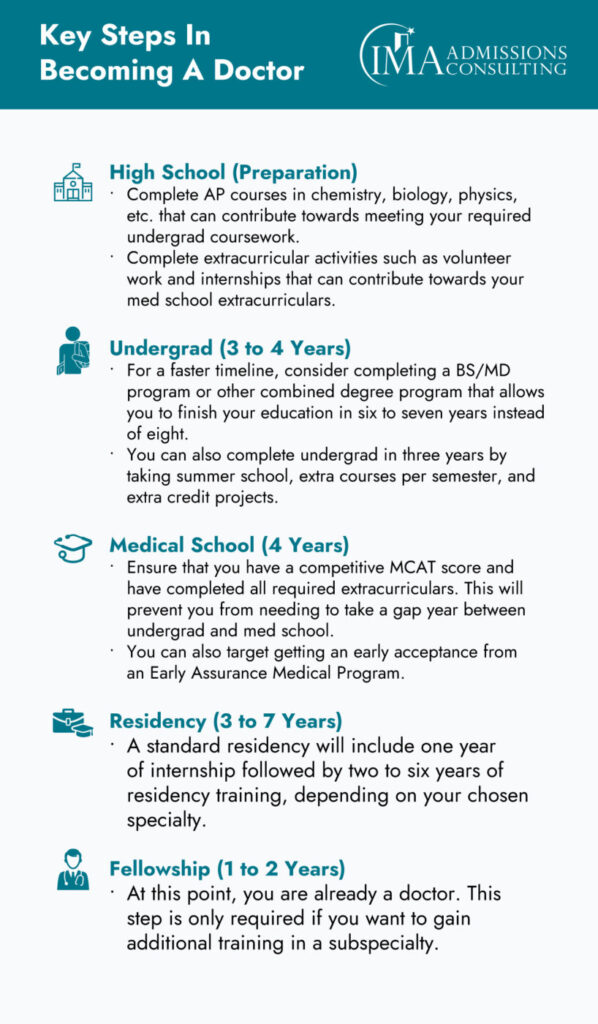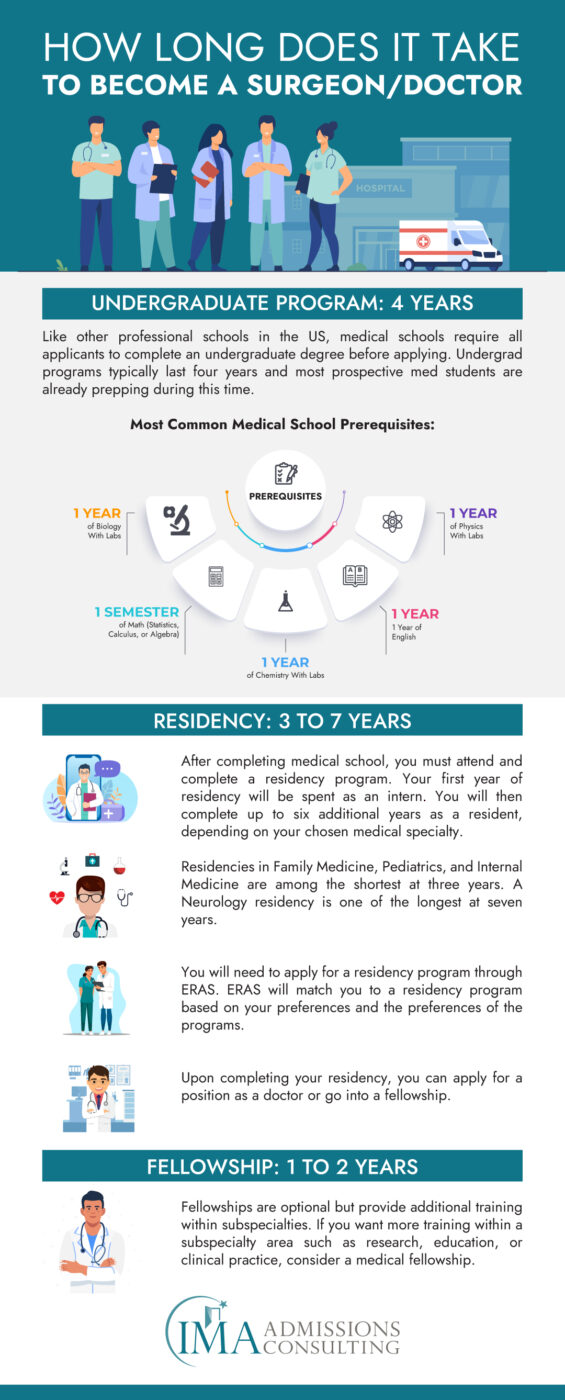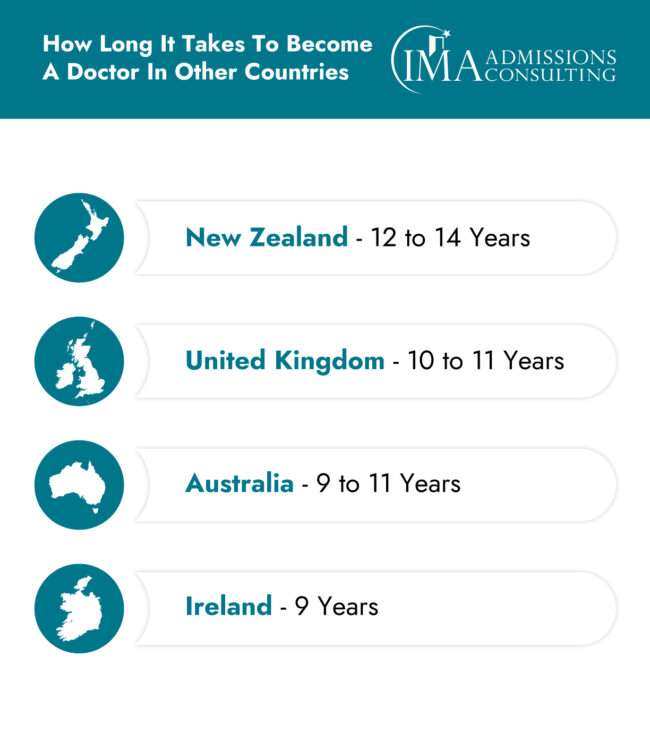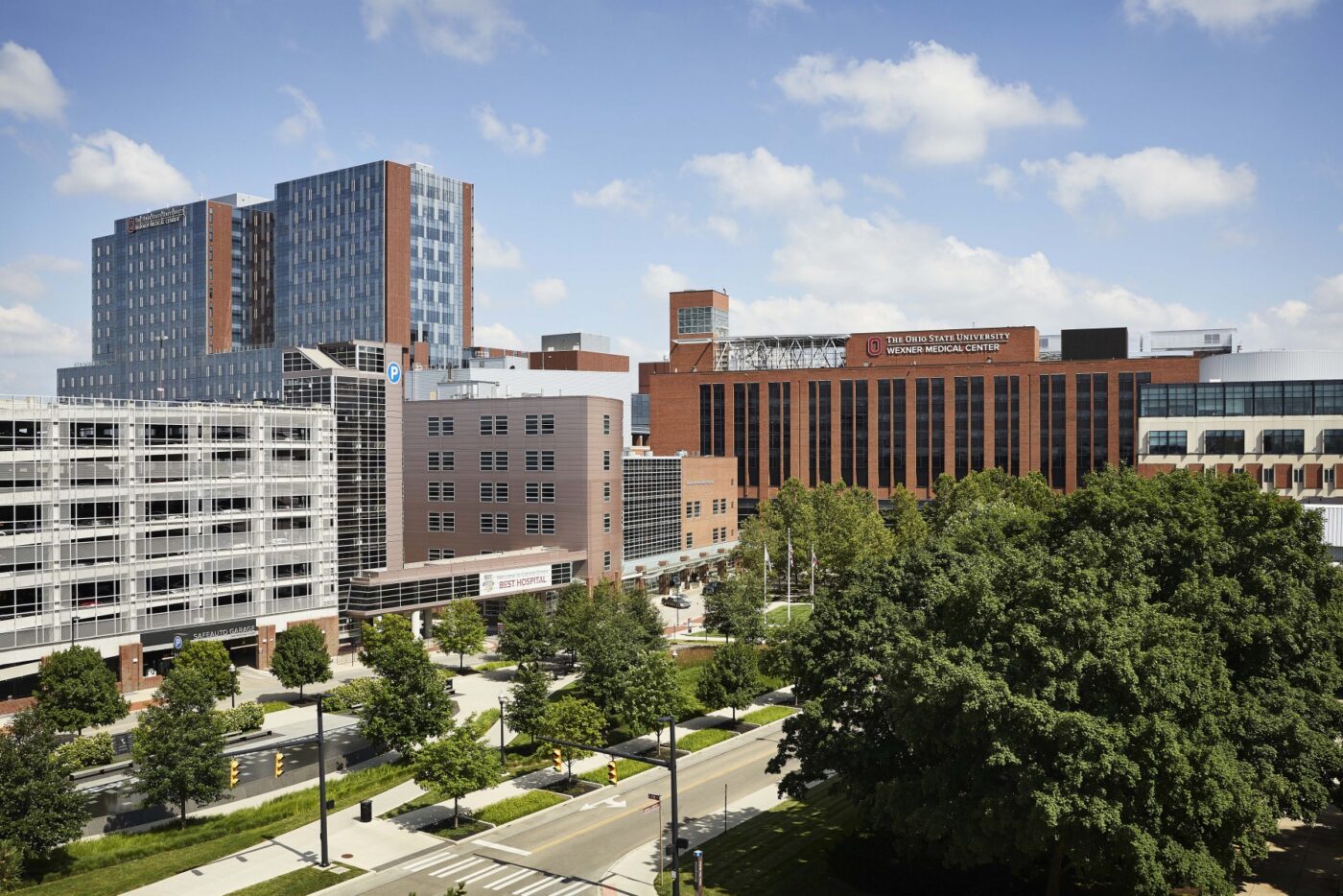How Long Does it Take to Become a Doctor?
If you want to become a doctor in the United States, you will need to complete a four-year undergraduate program, followed by attending medical school for four years. After you graduate from medical school, you will need to attend a residency program. You can be matched to a residency program through ERAS. Most graduates will spend between three to seven years in residency, depending on their medical specialty. Upon completing all schooling and a residency program, you will need to take a licensing exam for the state where you want to practice medicine.
Overall, this adds up to approximately 10 to 14 years to achieve a career as a doctor. Now, let’s chat about if it is possible to shorten the medical school timeline.
Can Someone Become a Doctor Before 30?
Based on the information and timeline provided above, it takes an average of twelve years to become a practicing medical professional. This number assumes that your residency lasts for four years. If we make the assumption that the average pre-med student is eighteen when they begin their undergraduate program, they will be 30 by the time they complete their education, residency, and licensing exams. This is the average age, but many pre-med students want to know if there is a way to shorten the timeline and become a licensed doctor before 30.
Achieving all of this before 30 is possible but is extremely challenging. Here are a few things you can do to become a doctor before turning 30.
- Early planning – You will need to know what your medical career goals and ambitions are in high school. If you know your goals while still in high school, you can get ahead on required coursework and extracurriculars.
- Choose the correct undergrad programs – You will need to choose the right undergrad program, med school program, and residency. Once you begin college and work towards your Bachelor’s, you will need to stick with the program you selected, as any change or delay can set you back. If you feel confident and certain about the career path you want to pursue, you should consider a BS/MD program. A BS/MD program may help accelerate your timeline, allowing you to graduate in three years instead of four. Some programs, although rare, offer the ability to combine your undergrad and medical school degrees into one, typically only requiring six years to complete. Keep in mind these programs are often highly sought after and extremely competitive.
- Choose a medical degree less than four years long – Yes, it’s true. There are medical programs that take under four years to complete. Some schools that offer programs under four years in length include Ohio State University and Columbia University Medical School. These programs take a shorter amount of time to complete, but students should prepare themselves for a more rigorous course than a standard four-year program.
- Consider residency length – Your choice of residency program plays a big role in how long it will take to become a doctor. Specialties such as internal medicine and pediatrics require three years of residency, while other specialties like neurological surgery require a six to seven-year residency. If you want to put yourself on the fast track to becoming an independent doctor, you need to consider the required residency length of each medical specialty.
- Academic background – Unfortunately, this won’t apply to everyone, but another factor in becoming a licensed doctor before age 30 is your age at the time of starting undergrad. Students who begin school earlier than their peers or are able to skip grades may begin their freshman year at age sixteen or seventeen, giving them a few additional years of study before hitting 30.
It’s not easy to become a doctor before 30, but it can be done. Next, let’s review what steps you should take to achieve the most direct path to practicing medicine.
What’s the Fastest Way to Become a Doctor?
The path to becoming a licensed doctor includes a few key steps that everyone must complete. To put yourself on the fastest path to becoming a doctor, you must make some key choices starting at a young age.
The following table highlights the key steps one must take to become a doctor and what one can do to speed up each stage of the process.

Undergraduate Program: 4 Years
Like other professional schools in the United States, medical schools require applicants to complete undergraduate degrees before applying. On average, an undergrad program lasts four years, and most prospective med school students are already prepping themselves during this time.
Although medical schools don’t require applicants to major in science, they do have a list of prerequisites that include science coursework.
The most common prerequisites for medical school are:
- 1 Year of Biology With Labs
- 1 Year of Chemistry With Labs. Some schools only require organic chemistry while others will require both organic and inorganic chemistry courses. Check your target school’s website for more detailed requirement information.
- 1 Year of Physics With Labs
- 1 Semester of Math (Calculus, Statistics, or Algebra)
- 1 Year of English
Throughout your premed years, you should also work towards completing any required extracurriculars for medical school. These are activities and experiences that will help you stand out amongst the sea of other medical school applicants. Focus on extracurricular activities that will catch the attention of the med school committees as they view your medical school resume.
Your preparation for becoming a doctor begins long before you obtain your bachelor’s degree. Your undergrad years are essential for gaining experience in clinical settings, shadowing doctors, serving your community, participating in research, and partaking in pre-med shadowing study abroad programs. These experiences will help you can the skills needed to become a successful physician.
Before you begin the next step after undergrad, you will need to apply for medical school, prep for interviews, and take the MCAT exam and CASPer exam if it is required.
Medical School: 4 Years
For those wondering, “how long is medical school” the simple answer is four years, but there’s more to medical school than that. Medical school is divided into phases. The first two years of med school are known as the pre-clinical or pre-clerkship phase and include mostly coursework. During these years, you will develop clinical and science skills in a classroom setting.
Upon completing your first two years of medical school, you will take the USMLE Step 1. This is a one-day exam that is designed to assess your understanding of the principles and mechanisms of disease, health, and therapy.
The next two years are much more hands-on. These years, known as the clerkship phase, include clinical rotations for several weeks at a time and learning by shadowing doctors in a hospital setting. Year three of med school includes core rotations at the school with the goal of exposing you to different fields of medicine. You will continue core rotations during your fourth year, but during this year, you will choose a particular field or specialty to include in rotations.
By the time you reach the end of your fourth year, you will need to take and pass the USMLE Step 2. The USMLE Step 2 includes both a one-day exam and interactions with patients.
Residency: 3 to 7 Years
After completing medical school, you will need to attend a residency program. During the first year of the residency program, you will spend as an intern, followed by up to six additional years as a resident, depending on your chosen medical specialty.
Some residencies are shorter, such as those for Family Medicine, Pediatrics, and Internal Medicine are around three years. Residencies for Pathology, Obstetrics/Gynecology, and Psychiatry are generally four years in length, and residencies for Urology, General Surgery, and Orthopedic Surgery are five years. Neurosurgery has one of the longest required residencies at seven years.
In the United States, you must apply for your residency through ERAS. ERAS will match you to a residency program based on your preferences and the preferences of the programs. When applying for residencies, it is important to be aware of which residency programs are the most competitive and remain realistic about your list of preferences.
After finishing your first year of residency, you will take the USMLE Step 3. The USMLE Step 3 is a licensing exam that evaluates if you can practice medicine without the need for supervision. Upon passing this exam, you can obtain a medical license in the state you wish to practice. At the end of your residency, you can choose to apply for a position as a doctor or go into a fellowship.
Fellowship: 1 to 2 years
Fellowships are optional as by this stage you are officially a medical doctor. However, if you decide that you would like additional training within a subspecialty area of research, clinical practice, or education, you may benefit from a fellowship.
To apply for a fellowship, you need to have already completed a residency in the specialty you want to focus on, and you must demonstrate significant experience and clinical skills in that area.

Non-Traditional Paths to Becoming a Doctor
The steps discussed above assume that you follow the traditional path to becoming a doctor, going from high school to college to med school to residency and then into the workforce. However, this isn’t always the case and some take a non-traditional route to become a doctor.
Let’s explore some non-traditional paths to becoming a doctor.
Gap Year Before Medical School
While most premed students apply to medical school the summer before their senior year of undergrad and upon completing their bachelor’s, many students decide to take a break of one or more years before attending med school.
There are many reasons why one would choose to do this. The best and most common approach is to utilize the gap year to improve their application. During this gap year, they can work on completing extracurriculars like volunteering or a pre-med shadowing study abroad program. This gap can also be used to complete any missing prerequisite courses or work a premed gap year job to help bolster one’s application. Another reason to take a gap year is to pay off one’s debts from undergraduate school before acquiring more debt from med school.
As long as you utilize this time productively and dedicate it to improving your skills and application, taking a gap year should not harm your chances of acceptance into medical school.
Post-Baccalaureate Premedical Programs
These programs, also referred to as “Postbacs,” are growing in popularity in the United States. If you were not enrolled in a pre-med program in college or received a low GPA in science, these programs allow you to improve your science GPA and take courses required for medical school.
Postbacs are offered by both undergraduate institutions and medical schools. Before you consider enrolling in one of these programs, do your due diligence, as each program is different. For further assistance in deciding what is the best option for you and your education, consider enlisting the aid of medical school admissions consulting.
Special Master’s Programs
SMPs (special master’s programs) are the graduate equivalent of postbacs. SMPs are a great way to improve your chances of being accepted into med school and expose you to many of the required experiences.
Typically, these programs take one to two years to complete. If you choose to take a thesis master’s degree, one year will be spent doing coursework and another year spent completing research and writing your thesis. If you choose to take a coursework program, this can be completed in one year.
Research-inclined students may even go for a PhD in a science discipline before applying to med school, adding up to five additional years to their journey to becoming a doctor.
For students who were unsuccessful in matching into a residency program, there are options you can pursue during the year before you can reapply for ERAS. You could potentially increase your chances of acceptance into a residency program by taking a job in a clinical setting (even if you are not working directly with patients) and taking the USMLE Step 3 in the meantime.
Career Change
Not everyone will discover their passion for medicine or ambition to become a doctor while in high school. Some individuals receive an education in another field and work in that field for years before deciding to change careers. Although many people successfully change career paths from all sorts of careers, the most common change occurs among those already in the medical field. Those working as paramedics, nurses, and even Physician Assistants often make the switch to becoming a doctor.
Those already working within the medical field already hold an undergrad degree and higher education pertaining to their initial career. However, their exact previous education experiences will vary depending on their chosen career path. For example, most PAs complete a four-year undergraduate degree followed by an additional two- to three-year master’s program. Paramedics, on the other hand, typically have a much shorter educational timeline with their training spanning anywhere from six months to four years, depending on the degree they receive.
Those who plan to switch careers may need to take a postbac program before applying to medical school or take a gap year to complete their application. Many choose to complete these steps alongside their work experience for financial reasons and to gain more experience.
No matter what the initial career or academic background is, it is a given that if you are switching careers, you will be older than your average 22-year-old first-year med school student. Depending on how much career experience you have, you may be anywhere between 25 and 40 plus.
Your age when entering your first year of medical school doesn’t make you any less likely to find success. Often, those who are switching career paths find that their previous knowledge and experiences in another field are an asset during medical school training. The motivation for a career switch is typically passion and an undeniable calling towards becoming a doctor, meaning those who make a late-stage career change are often more dedicated, determined, and motivated.
How Long Does it Take to Become a Doctor in Other Countries?
Becoming a doctor in other countries takes approximately the same amount of time as it does in the United States. For example, in Canada, aspiring physicians need to complete an undergrad degree (three to four years) before attending medical school (four years) and completing a residency program (two to five years).
Here is how long it takes to become a doctor in other English-speaking countries:

Frequently Asked Questions
How long does it take to become a surgeon and/or doctor?
Aside from “how long is medical school,” this is one of the most common questions aspiring med students ask. In the United States, it takes an average of 10 to 14 years to become a doctor or surgeon. This includes a four-year undergrad degree, four years of medical school, and three to seven years of residency.
Can I become a doctor before 30?
Yes, it is possible to become a doctor before the age of 30, but it is not an easy path. If you want to become an independent doctor before 30, you will need to strategically plan your education and residency. This accelerated path into the medical field isn’t right for everyone, and we suggest seeking the guidance of a medical school admissions consulting service to figure out what’s best for you.
Is becoming a doctor worth the time invested?
After asking, “how long is medical school” and learning that it could take up to 14 years to become a doctor, you’re probably wondering if the career is worth the time. The path to becoming a doctor isn’t easy, but for those who have a true passion for helping others and the medical field, the career is well worth the time, money, and effort invested.
Doctors have one of the best-paying traditional jobs available, with many earning an average salary of $200k to $300k per year. Physicians are also rewarded through non-monetary and intangible means such as making research breakthroughs and helping patients on a day-to-day basis.
Do MD programs take longer to complete than DO programs?
No, both MD and DO programs take four years to complete.
What age should I expect to become a doctor?
The average beginning age of a med school student is 24, and most will become licensed doctors in their mid to late 30s.
Does medical school have an age limit?
No, most medical schools do not have any age limits in place. You can become a doctor at any age or stage in your life. The only exception is those who want to become military doctors as most military services have upper age limit restrictions.
Will a gap year hurt my chances of getting accepted into medical school?
If you spend your time off preparing for medical school and participating in extracurriculars to make your application more competitive, no a gap year will not harm your chances of being accepted.
What should I do if I don’t match to a residency program?
If you don’t match to a residency program, don’t get discouraged. Stay connected to your school and apply for a job in a clinical or research lab setting. The experience gained from a research/clinic job may help you with your next residency application.
How old can my prerequisites and coursework be?
While the majority of medical schools don’t have strict policies about how old coursework and prerequisites can be, most like to see coursework completed within five years before applying to med school.
Why does it take so long to become a doctor?
In the US, there are several reasons why it takes such a long time to become a doctor.
- You must complete an undergrad degree before applying to medical school
- The medical profession requires a lot of responsibility, which is why residency often takes years to complete. Residency is designed to ensure you can take care of patients without supervision.
- Doctors must have a license. Obtaining a medical license requires one to prove that they have years of knowledge and training in the field, and they must be able to pass the certification exam.







